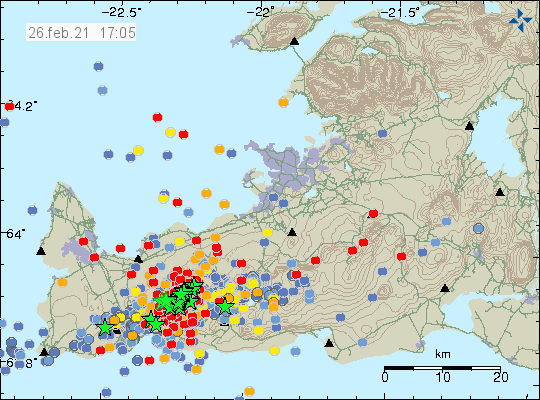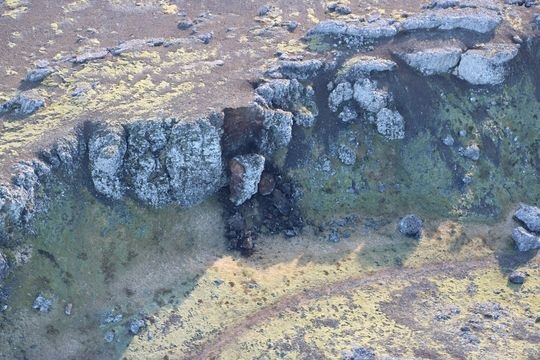Update from 02.26.2021:
Things are starting to look a bit more interesting on the Reykjanes Peninsula, Iceland.

The types of earthquakes have started to evolve a bit (towards volcanic), and the GPS trajectories are pointing towards inflation of both Krysuvik and Fagradalsfjall indicating movement of volcanic fluids.
So, we can now sit down with a bag of marshmallows and wait to see if it will be Thorbjörn, Fagradalsfjall or Krysuvik that will go off, IF the current activity continues.
Both Thorbjörn and Fagradalsfjall could be a bit bothersome for Grindavík. Krysuvik would only be a boomer for the famous café at Cold Arse (Kaldársél).
Original article from 02.24.2021:
As shown in the map below, Iceland is shaking hard today.
Even the manager of Vedur said: “I think we’ve never seen anything like it on the Reykjanes peninsula.”

A powerful earthquake swarm began on the Reykjanes peninsula this morning when two quakes at or over Magnitude 5 struck just after 10.00 am local time.
Meanwhile, some 40 quakes larger than M3 have been recorded, and over ten bigger than M4. No damage to buildings or infrastructure has been reported, or any injuries — though loose items in some people’s homes were damaged or broken.
The biggest quake’s epicentre was 3.3 kilometres southwest of Keilir mountain at 10.05. It was Magnitude 5.7. The Met Office warns on its website that there is an increased risk of rockfalls and landslides.

The swarm continues at this time and aftershocks tend to be short and sharp, and many have been felt clearly in the capital region. The seismic activity is all taking place on the Reykjanes peninsula.
Kristín Jónsdóttir, natural disaster monitoring manager at the Met Office, told RÚV news that the earthquake swarm is unusual for featuring so many large quakes in such a short time. “I think we’ve never seen anything like it on the Reykjanes peninsula. It’s likely around ten quakes that are over four, and some of them were larger than five.”
What makes this swarm unusual is that it has two active zones. One is to the east under Fagradalsfjall, and the other is in a similar spot to the 20th October quake: Núpshlíðarháls.
Kristín Jónsdóttir, director of Vedur.is explained that the area is locked and does not release tension except in larger earthquakes:
“We are in the middle of an event now. We believe that while this instability is ongoing, there is an increased chance that there will be even more earthquakes and even larger earthquakes.”
Although unusual, there is no indication of eruptions, say scientists on-site. More info on Vedur and Ruv.
Well, let’s wait a bit longer until a Big One strikes the region and triggers a powerful eruption! Be prepared!
Now subscribe to this blog to get more amazing news curated just for you right in your inbox on a daily basis (here an example of our new newsletter).
You can also follow us on Facebook and/ or Twitter. And, by the way you can also make a donation through Paypal. Thank you!
To get more in-deep information I recommend Q-Files. Quick the image below!














Hmmm, good and glad nobody was injured. Iceland is one place I would like to visit. Seems like hiking, hunting, fishing in the glaciers would be exciting. Probably more so, if I were 30 again.
Yes it really looks awesome! I love fishing too 🙂
????
?